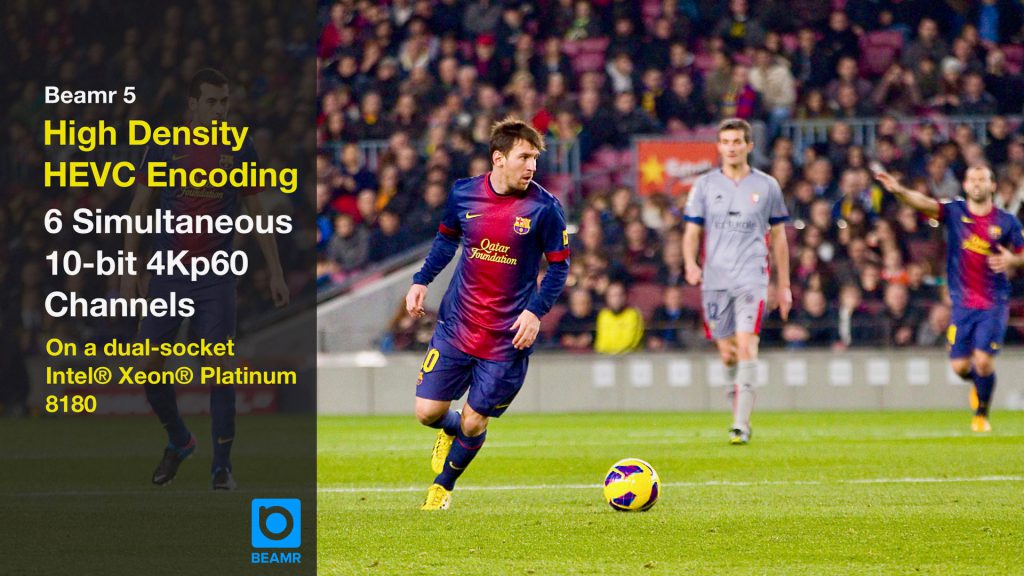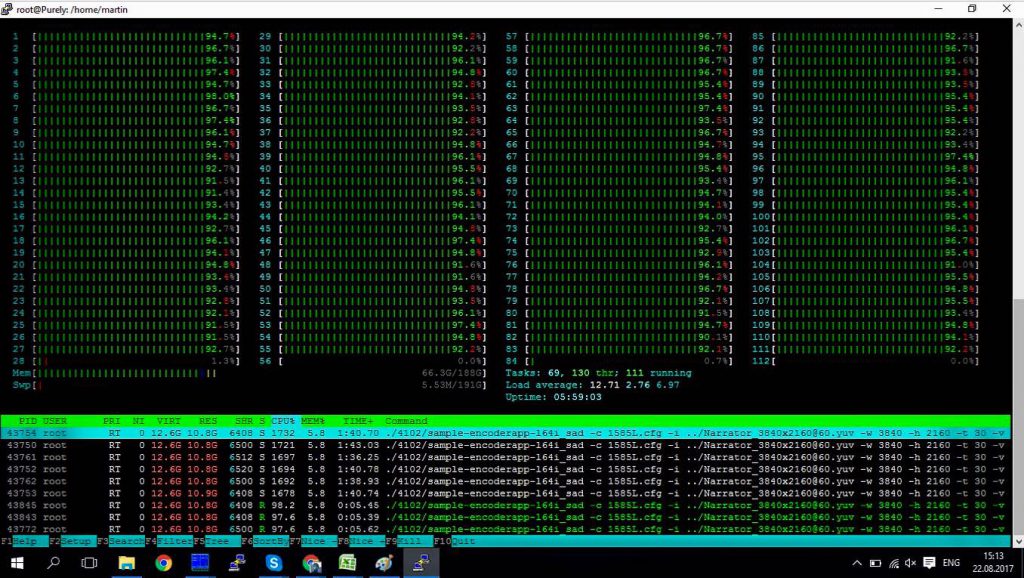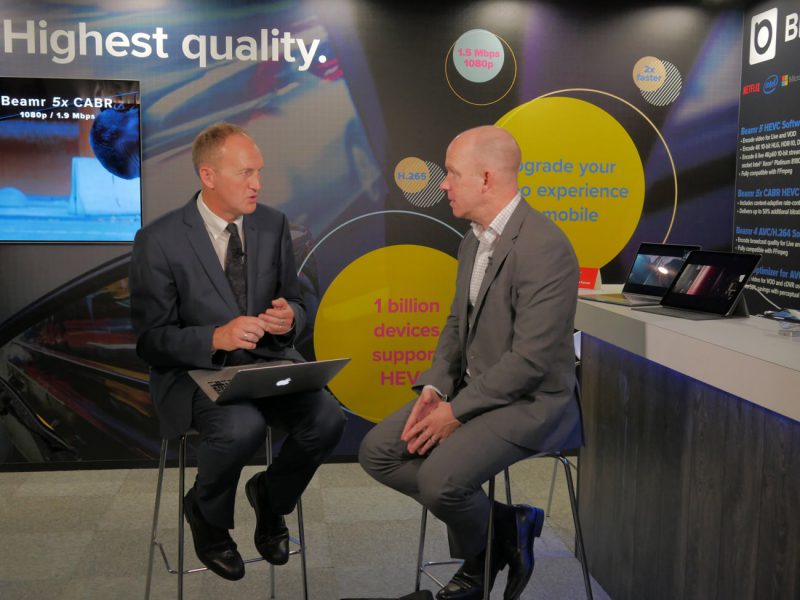It’s no secret that Intel-based hardware is ubiquitous in many video encoding data centers, which explains the high level of interest in the new Intel® Xeon® Scalable Platinum processor family. This article examines the live HEVC 4Kp60 10-bit encoding performance from the perspective of speed with Beamr 5 running on the scalable Platinum 8180 where the results are nothing short of amazing.
Intel is known for pushing the state of art with ever faster and more capable processors, which enable software encoding vendors like Beamr to achieve performance benchmarks some thought impossible. Since Intel’s announcement of their new processor series, Beamr has been excited to see what is possible with the version 5 Xeon® processor.
The result?
Mind-blowing.
Video services needing to encode live 4Kp60 10-bit HDR video can achieve 6 simultaneous streams on a dual-socket Intel® Xeon® Scalable Platinum 8180 processor using Beamr 5 v4.1. This performance represents a 6x speed advantage over x265 and establishes an entirely new benchmark for HEVC software encoders.

CLICK HERE for a speed comparison of the Beamr 5 HEVC software encoder and x265 running on Amazon EC2.
Executive Introduction
As over-the-top (OTT) and IP overtake traditional linear delivery systems, the ability to encode video on software, in real time, is now a requirement.
- According to Cisco, consumer Video-on-Demand (VoD) traffic will almost double by 2021. This trend is driven largely by new video services and entertainment formats such as Cloud DVR, UHD (4K), High Dynamic Range (HDR) and 360 degree AR/VR immersive video. These advanced video formats carry with them much greater encoding complexity which places high operational demands on the computing environment. This means more efficient software requires less server time which translates to fewer machines and lower capex and opex.
- With content and operational costs rising, and end user pricing under pressure, it is essential for operators to invest in video encoding technology that can provide advanced services in the most efficient way possible. As NFV and virtualized container based architectures advance in the data center, encoding density and speed is becoming a critical vector within the encoder selection process. Also, the ability to operate across a wide range of general purpose platforms is essential. Many GPU bound solutions are inextricably linked to a single processor or limited series. Beamr’s HEVC encoder scales across the entire Intel® Xeon® family.
- Apple is playing a pivotal role in enabling the HEVC ecosystem starting with iOS 11 and High Sierra. It is estimated that up to 1 billion devices in the Apple ecosystem can now play HEVC without any special update or third-party apps needed. With HEVC files now supported from big screens to mobile devices, video services can transition their entire library with all resolutions to HEVC, and benefit from the reduced bitrate and improved quality that HEVC is able to deliver. This represents hundreds of thousands if not millions of hours of content needing to be encoded by each video distributor.
With Beamr 5 running on an Intel® Xeon® Scalable processor, video encoding engineers can perform up to 6 times more live video encoding, which leads to a reduction in:
- Power
- Rackspace
- Capital investment
For more background, read Intel’s Solution Brief’s on the Intel® Xeon® Scalable processor family and the Beamr 5 HEVC video encoder.

The new Beamr 5 HEVC software encoder exploits multiple features of the Intel® Xeon® Scalable platform, making it possible to deliver the performance of hardware with the scale and flexibility that only software allows. Beamr 5 is able to utilize the entire range of Intel® Xeon® processors from the entry-level Intel® Xeon® Processor E3 v5 family to the best in class Intel® Xeon® Platinum Scalable 8180 processor. For real-time live video encoding operations that require resolutions up to 4K and frame rates as high as 60 FPS, higher performance means less computing resources required.
Solutions like Beamr 5 running on Intel® Xeon® Scalable Platinum processors contribute to decidedly lower operational and capital investment costs.
In addition to the live workflow benefits, offline VoD applications can also benefit from greater performance as the shorter turnaround time to complete VoD encodes and transcodes means the content will be available for distribution more quickly.
Beamr 5 opens up compelling options for MSOs, CDNs, and broadcasters to build video workflows that exceed their service expansion plans and technical goals while also enabling service operators to deploy media processing workflows across public clouds and on-premise data centers.
With Beamr 5 running on Intel® Xeon® processors, new video encoding workflows can be imagined as edge encoding services running Intel® Xeon® E3 processor-based points of presence (PoPs) for JIT transcoding are now possible. The high performance of Beamr 5 directly enables workflows to be split and re-deployed without a need to redesign workflows.

Beamr’s Next-Generation Video Encoding Technology on Intel
At the foundation of Beamr’s HEVC software encoder is technology that stems from more than a dozen years of codec development by our codec engineering team. Though we’ve developed our solution and technical advantages entirely in-house, working closely with Intel gives us a significant technical and business advantage.
Of the many points related to how we achieved our massive speed advantage, the two we will highlight are motion estimation advantage and micro-level parallelization.
Incoming frames are extensively analyzed by Beamr 5. It is this step which determines the complexity of the scene as rough motion vectors are calculated, and estimates for the bit demand of the encoded frame are made. These estimates guide the second stage of the encoder and allow those activities to focus on visually meaningful aspects of the frame. By partitioning the encoding process, unproductive calculations can be avoided, thus improving the speed of the encoder and the quality it produces.
Second, Beamr 5 features micro-level parallelization which is the result of the codec engineering team leveraging software engineering lessons learned from earlier generations of Beamr real-time software encoders. This experience led the team to design a micro-level parallelization approach that stages portions of the encoding tasks in a controlled manner, staggering their execution so each micro-task begins when the data is available (and still in the cache). This results in wasteful power and CPU cycles spent writing and fetching data being eliminated. Careful design of these micro-tasks assures that they are executed efficiently across the whole frame and in an even manner so that all cores are kept uniformly busy, and none are left waiting for their next task.
Uniquely, the Beamr encoder does not rely on the operating system to manage these critical execution threads but instead is under full control of the pooling and process allocation between the available cores and threads. Beamr’s advanced encoder controls the execution priority based on the availability of pipelined data.
Test Methodology
As in part 1 of our x265 vs. Beamr 5 performance test, we encourage you to experience our speed claims first hand. For qualified video distributors, services and platforms, we are happy to offer a FREE evaluation agreement. To take advantage of this, please contact sales@beamr.com.
The purpose of this test was to measure the speed of Beamr 5 for live encoding applications running on Intel® Xeon® Scalable Platinum processors. In our first comparison of codec performance based on CPU, we decided to run a few comparisons with x265. For this comparison, x265 was benchmarked in its fastest speed setting ‘ultrafast’ – while for Beamr 5 we operated the encoder at its highest speed setting “15” with the performance boost modifier ‘TURBO1’ which activated our latest algorithmic improvements that are available in version 4.1. (All files were 4Kp60.)
For this second test, we wanted to dig deeper using Beamr 5 version 4.1 running on the same 2S Intel® Xeon® Platinum 8180 processor-based machine that we tested with in September, to see what gains were possible. What we found was nothing short of stunning.
In Graphic 1, HTOP shows Beamr 5 loaded 108 threads (from 112 available) at an impressive 90% utilization rate. This demonstrates the high degree of effectiveness with our Intel specific optimization.
Graphic 1: HTOP Intel 8180 dual socket 108 thread utilization at 90% across each thread.

More speed and performance benchmarks from Intel: CLICK HERE.
Conclusion
The drive to increase density with software-based video encoding and transcoding infrastructure is key to securing a competitive advantage for multi-service operators, OTT video distributors, and content distribution networks. At the same time, video architects must enable encoding and delivery of advanced entertainment content, by embracing new technologies, capabilities, and codecs such as HEVC, HDR, and 4K.
With a Beamr + Intel® Xeon® optimized video encoding solution, density – efficiency – quality – and flexibility of video encoding operations for on-premises, cloud, and hybrid data centers can be realized. Beamr 5 running on Intel® Xeon® Scalable processors offers TCO benefits and provides a meaningful improvement to the video processing capabilities of any video distribution solution.
If you missed part 1 of this post, be sure to check it out since additional technical details about Beamr 5 and its operational and performance advantages against x265 were specifically discussed. Find the x265 vs. Beamr 5 Speed Test here.

